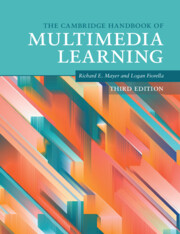Book contents
- The Cambridge Handbook of Multimedia Learning
- The Cambridge Handbook of Multimedia Learning
- Copyright page
- Contents
- Figures
- Tables
- Contributors
- Preface
- Acknowledgments
- Part I Background
- Part II Theoretical Foundations
- 5 Cognitive Theory of Multimedia Learning
- 6 Implications of Cognitive Load Theory for Multimedia Learning
- 7 Integrated Model of Text and Picture Comprehension
- 8 Implications of the Four Component Instructional Design Model for Multimedia Learning
- 9 Motivation and Affect in Multimedia Learning
- 10 Metacognition in Multimedia Learning
- Part III Basic Principles of Multimedia Learning
- Part IV Principles for Reducing Extraneous Processing in Multimedia Learning
- Part V Principles for Managing Essential Processing in Multimedia Learning
- Part VI Principles Based on Social and Affective Features of Multimedia Learning
- Part VII Principles Based on Generative Activity in Multimedia Learning
- Part VIII Multimedia Learning with Media
- Author Index
- Subject Index
- References
10 - Metacognition in Multimedia Learning
from Part II - Theoretical Foundations
Published online by Cambridge University Press: 19 November 2021
- The Cambridge Handbook of Multimedia Learning
- The Cambridge Handbook of Multimedia Learning
- Copyright page
- Contents
- Figures
- Tables
- Contributors
- Preface
- Acknowledgments
- Part I Background
- Part II Theoretical Foundations
- 5 Cognitive Theory of Multimedia Learning
- 6 Implications of Cognitive Load Theory for Multimedia Learning
- 7 Integrated Model of Text and Picture Comprehension
- 8 Implications of the Four Component Instructional Design Model for Multimedia Learning
- 9 Motivation and Affect in Multimedia Learning
- 10 Metacognition in Multimedia Learning
- Part III Basic Principles of Multimedia Learning
- Part IV Principles for Reducing Extraneous Processing in Multimedia Learning
- Part V Principles for Managing Essential Processing in Multimedia Learning
- Part VI Principles Based on Social and Affective Features of Multimedia Learning
- Part VII Principles Based on Generative Activity in Multimedia Learning
- Part VIII Multimedia Learning with Media
- Author Index
- Subject Index
- References
Summary
Cognitive and metacognitive strategies are key to successful learning with multimedia; however, research shows that learners rarely use these strategies effectively and consequently fail to develop a deep understanding of complex topics and domains. Dynamically and accurately monitoring and regulating one’s own cognitive and metacognitive strategies is necessary to be a successful learner but demands an enormous amount of effort. In this chapter, we (1) define metacognitive strategies during multimedia learning; (2) review recent empirical literature on metacognitive strategies during multimedia learning; (3) present a new model of multimedia learning ; (4) provide recommendations for augmenting contemporary cognitive theories of multimedia learning to account for metacognition; (5) propose empirically-based principles for designing multimedia environments aimed at fostering metacognitive strategies; and finally (6) highlight directions for future research.
Keywords
- Type
- Chapter
- Information
- The Cambridge Handbook of Multimedia Learning , pp. 132 - 142Publisher: Cambridge University PressPrint publication year: 2021
References
- 2
- Cited by



